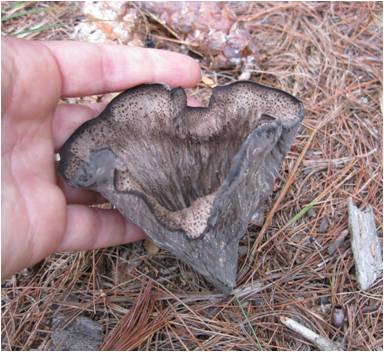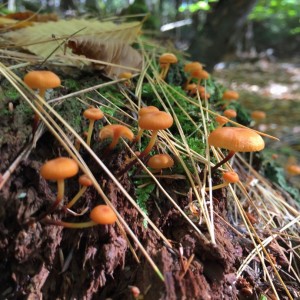My obsession of late is foraging wild mushrooms…something about the weather conditions in late summer have made this a spectacular year for mushrooms here in southern New Hampshire. The woods are full of mushrooms of all shapes and sizes. I only know one edible species – black trumpets. Every time I go for a walk in the wo ods near my house I carefully scan the ground looking for where these mushrooms have sprouted. I now have regular spots where I have found them before and return to find them again, plus it is a thrill to discover new places. The thrill of finding them is surpassed by the thrill of eating them…fried in butter, mixed into scrambled eggs, or as the base for a soup stock for wild mushroom risotto.
ods near my house I carefully scan the ground looking for where these mushrooms have sprouted. I now have regular spots where I have found them before and return to find them again, plus it is a thrill to discover new places. The thrill of finding them is surpassed by the thrill of eating them…fried in butter, mixed into scrambled eggs, or as the base for a soup stock for wild mushroom risotto.
All this time out looking for mushrooms has me musing about the conditions that come together for a mushroom to sprout. I can check a place many times through the year and only when there is the right combination of rain, warm weather, nutrients, and who knows what else, will the mushrooms suddenly appear. This can be a metaphor for how to design and facilitate networks – with the right conditions, great results can emerge from collaboration, where together people can achieve way more than they could alone. Though without the right conditions, the same group of people can become mired in debate, details, group think, or miss connections and possibilities that are there but are never realized.
One of the key conditions for catalyzing a network is to create space where participants can learn about each other’s work, needs, and resources, and discover ways to help each other. In working with the Global Warming Solutions Project, a network focused on climate action in Massachusetts, our initial meetings agendas mainly focused on specific outcomes to make progress on our joint work. After meeting together a while, we took time for each participant to share how their work related to the broad goals and what they were working on that others might have interest in. This conversation surfaced a number of specific ways that participants could work with each other in “micro-collaborations” and we discovered assets and resources within the group that had not been fully recognized.
 This can be called “design for serendipity” – creating environments or conditions in person and on line where helpful connections can be formed, as Diana Scearce writes in The Power & Peril of Networks. An emphasis on action and results can lead to overly-structured environments that do not allow the space for the fruitful interconnections and deeper relationships among members to emerge. (My personal pet peeve is when conference organizers pack the agenda full of panels of speakers and then at lunch, just when you get a chance to meet new people, find new connections, and reflect on what you have heard, they tee up yet another speaker.)
This can be called “design for serendipity” – creating environments or conditions in person and on line where helpful connections can be formed, as Diana Scearce writes in The Power & Peril of Networks. An emphasis on action and results can lead to overly-structured environments that do not allow the space for the fruitful interconnections and deeper relationships among members to emerge. (My personal pet peeve is when conference organizers pack the agenda full of panels of speakers and then at lunch, just when you get a chance to meet new people, find new connections, and reflect on what you have heard, they tee up yet another speaker.)
These blogs offer more ideas on how to create conditions for new connections:
- Promote collaborative learning among network members
- Strengthen connections
- Leverage the skills/resources of network members
- Catalyze new collaborations, e.g., micro-collaborations
Under the right conditions, a mushroom can grow from a microscopic spore to a full mushroom in two days. How can we create the conditions to enable our collaborations to mushroom in their impact and benefits?
For more ideas on how nature can inspire our thinking and designs for collaborative work, see this blog on Blueprints for Collaboration from Nature.
